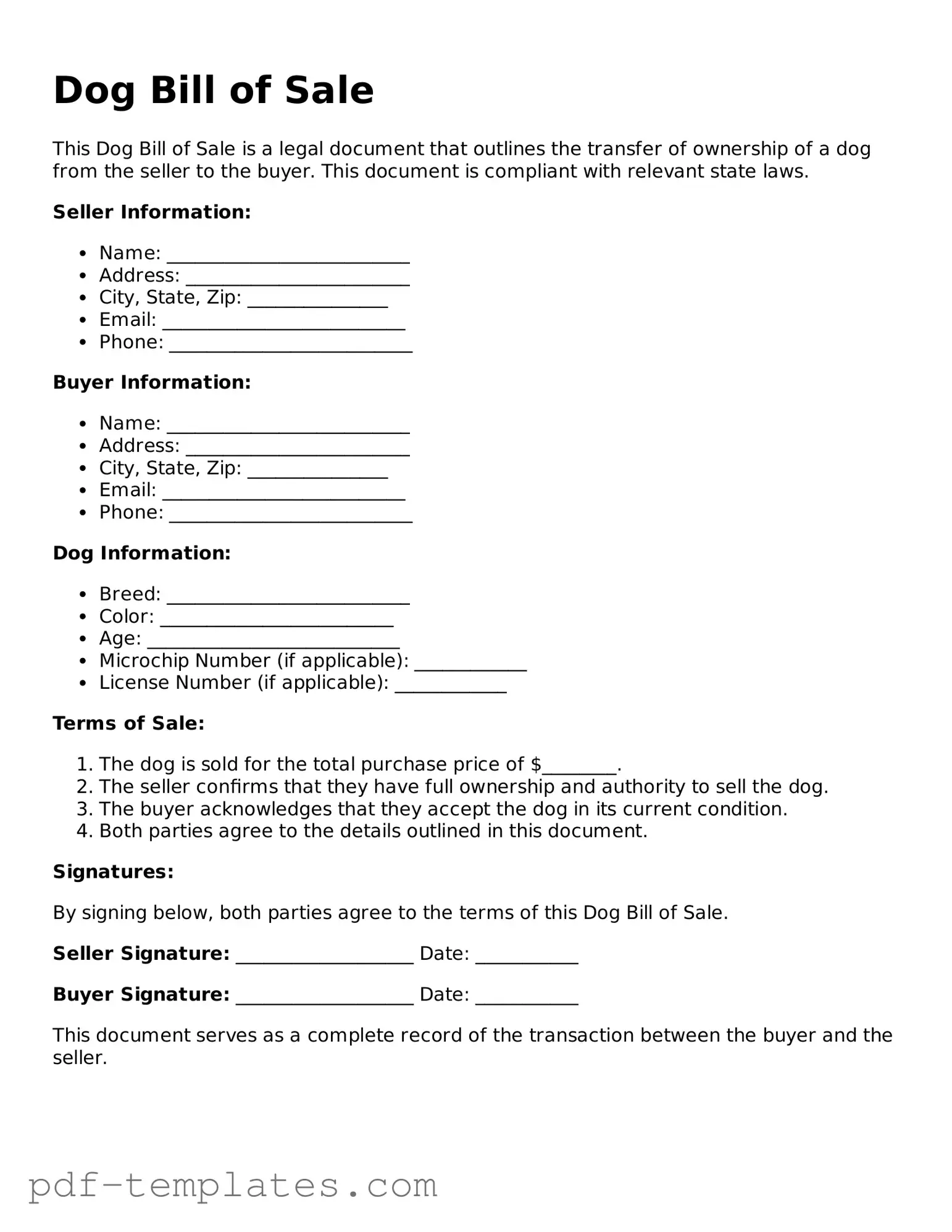The Dog Bill of Sale form is similar to a Vehicle Bill of Sale. Both documents serve as proof of transfer of ownership. In the case of a vehicle, the seller provides details about the car, including make, model, and VIN. Similarly, the Dog Bill of Sale includes information about the dog, such as breed, age, and any identifying features. Both forms protect the rights of the buyer and seller, ensuring that the transaction is legally recognized.
Another document comparable to the Dog Bill of Sale is the Pet Adoption Agreement. This form is often used by shelters and rescue organizations to formalize the adoption process. Like the Dog Bill of Sale, it outlines the responsibilities of the new owner and may include information about the pet’s health and behavior. Both documents emphasize the importance of responsible ownership and may include clauses regarding returns or rehoming the pet.
The Lease Agreement is also similar, particularly when it comes to rental properties that allow pets. This document specifies the terms under which a tenant can keep a pet in a rental unit. Just as the Dog Bill of Sale details the terms of sale, a Lease Agreement outlines pet policies, including deposits and restrictions. Both documents aim to protect the rights of the parties involved while ensuring that responsibilities are clear.
The Bill of Sale for Personal Property is another relevant document. This form is used for various items, not just pets. It provides proof of ownership transfer and includes details about the item being sold. Like the Dog Bill of Sale, it includes seller and buyer information and the sale price. Both documents serve as legal evidence of a transaction, ensuring clarity and protection for both parties.
A Rental Agreement for pets is similar as well. This document outlines the terms and conditions under which a pet may reside in a rental property. It often includes pet deposits and rules regarding pet behavior. Just as the Dog Bill of Sale confirms ownership, a Rental Agreement establishes the terms for keeping a pet in a rented space, ensuring both parties understand their rights and responsibilities.
In reviewing various documents that establish proof of ownership and terms for transactions, it's crucial to consider the California Loan Agreement form, which is essential for defining the relationship between borrowers and lenders within the state. Just as the Dog Bill of Sale solidifies the transfer of pet ownership, the California Loan Agreement ensures all parties are clear on the loan's specifics, including amount, interest rates, and repayment terms. For those looking for comprehensive resources regarding legal agreements in California, you can refer to All California Forms, which provide a variety of templates to assist with these transactions.
The Adoption Contract for animals mirrors the Dog Bill of Sale in its purpose to formalize the transfer of ownership. This document is typically used by rescue organizations and includes information about the animal's care, behavior, and health. Both forms require the new owner to acknowledge their responsibilities, emphasizing the commitment involved in pet ownership.
The Sales Agreement for livestock is another document that shares similarities with the Dog Bill of Sale. This form is used in agricultural contexts to transfer ownership of animals such as cows, pigs, or sheep. Like the Dog Bill of Sale, it includes details about the animal and the terms of sale. Both documents ensure that the transaction is recorded and that the rights of both parties are protected.
Lastly, the Transfer of Ownership form for pets is akin to the Dog Bill of Sale. This document is often used when a pet is given to a new owner, whether through sale or gifting. It outlines the details of the pet and confirms the transfer of ownership. Both forms serve to document the change in ownership and protect the interests of both the giver and the recipient.
